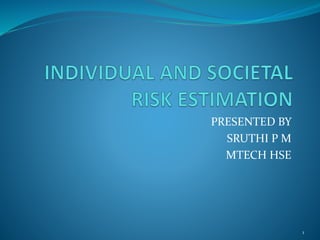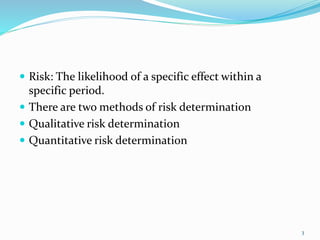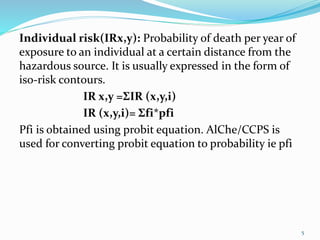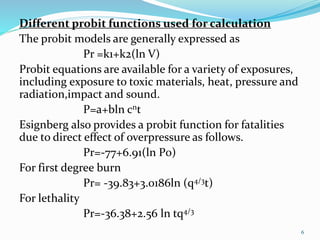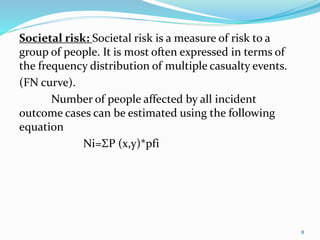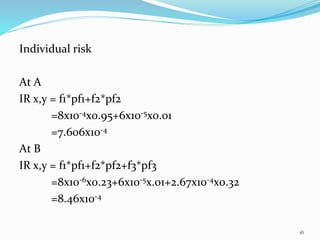Individual and societal risk
- 1. PRESENTED BY SRUTHI P M MTECH HSE 1
- 3. ÔÇó Risk: The likelihood of a specific effect within a specific period. ÔÇó There are two methods of risk determination ÔÇó Qualitative risk determination ÔÇó Quantitative risk determination 3
- 4. QUANTITATIVE RISK DETERMINATION ÔÇó Risk indices are single numbers or tabulation of numbers which are correlated to the magnitude of risk. ÔÇó Some risk indices are relative values with no specific units, which only have meaning within the context of the risk index calculations. ÔÇó The main two risk sets are ÔÇó Individual risk ÔÇó Societal risk 4
- 5. Individual risk(IRx,y): Probability of death per year of exposure to an individual at a certain distance from the hazardous source. It is usually expressed in the form of iso-risk contours. IR x,y =ΣIR (x,y,i) IR (x,y,i)= Σfi*pfi Pfi is obtained using probit equation. AlChe/CCPS is used for converting probit equation to probability ie pfi 5
- 6. Different probit functions used for calculation The probit models are generally expressed as Pr =k1+k2(ln V) Probit equations are available for a variety of exposures, including exposure to toxic materials, heat, pressure and radiation,impact and sound. P=a+bln cnt Esignberg also provides a probit function for fatalities due to direct effect of overpressure as follows. Pr=-77+6.91(ln P0) For first degree burn Pr= -39.83+3.0186ln (q4/3t) For lethality Pr=-36.38+2.56 ln tq4/3 6
- 7. 7
- 8. Societal risk: Societal risk is a measure of risk to a group of people. It is most often expressed in terms of the frequency distribution of multiple casualty events. (FN curve). Number of people affected by all incident outcome cases can be estimated using the following equation Ni=ΣP (x,y)*pfi 8
- 9. 9
- 10. ÔÇó There are three cylinders in a factory. First cylinder is filled with LPG in the horizontal cylinder. Second cylinder is filled with cyclohexane in the vertical cylinder. Third cylinder is filled with Benzene in the vertical cylinder. The wind speed in the region is 4.1 m/s. The ambient temperature is 25ÀöC. Determine the individual risk and societal risk. 10
- 11. ÔÇó Assume the values of frequencies of incident outcome cases as ÔÇó BLEVE of LPG -8x10-4 ÔÇó VCE of cyclohexane -6x10-5 ÔÇó Pool fire of Benzene-2.67x10-4 11
- 12. BLEVE of LPG ÔÇó For LPG, Consider the case of lethality, Pr=-36.38+2.56 ln tq4/3 Assume t= 82.58 sec. q=10800w/m2 Pr1 = -36.38+2.56 ln 82.58x(10800)4/3 =6.62 From the conversion table Pf1= 0.95 12
- 13. VCE of cyclohexane ÔÇó For cyclohexane, Consider the case of 1st degree burning, Pr2=-39.83+3.186ln tq4/3 q=4200 t=9.25 Pr2=-39.83+3.186ln 9.25x(4200)4/3 =2.7 pf2= .01 13
- 14. Pool fire model of benzene Pr= a+bln cnt here a=-9.82 b=0.71 n=2 (from World Bank) Assume c=1000ppm t=600 min. Pr3=-9.82+0.71 ln(1000)2 x600 =4.53 pf3=0.32 14
- 15. 15
- 16. Individual risk At A IR x,y = f1*pf1+f2*pf2 =8x10-4x0.95+6x10-5x0.01 =7.606x10-4 At B IR x,y = f1*pf1+f2*pf2+f3*pf3 =8x10-6x0.23+6x10-5x.01+2.67x10-4x0.32 =8.46x10-4 16
- 17. At C IR x,y = f1*pf1+f3*pf3 =8x10-4x0.95+2.67x10-4x0.32 =8.45x10-4 At D IR x,y = f2*pf2+f3*pf3 =6x10-5x.01+2.67x10-4x0.32 =8.604x10-5 17
- 18. Societal risk Assume P a=1000, P b= 2000, Pc=3000, Pd= 4000 N1=P a*pf1+P b*pf1+ Pc*pf1 =1000x0.95+2000x0.95+3000x0.95 =5700 N2=P a*pf2+P b*pf2+Pd*pf2 =1000x0.01+2000x0.01+4000*0.01 =70 N3=P b*pf3+Pc*pf3+Pd*pf3 =2000x0.32+3000x0.32+4000x0.32 =2880 18
- 19. 19
